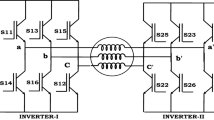Abstract
Random space vector modulation (RSVM) is a new switching technique used in power converters to spread the power spectrum of the output voltage to reduce its amplitude. This technique is attracting interest for the reduction of both of electromagnetic interferences and acoustic noise in variable speed drives (VSDs). The existing simple RSVM schemes (one random parameter) are: random switching frequency (RSF-SVM), random zero vector (RZV-SVM) and random pulse position (RPP-SVM). In this paper, we propose a combination of the three simple schemes (RSF–RZV–RPP)-SVM that we call triple RSVM (TRSVM) technique, for the control of the three-phase inverter. After an overview on the classical deterministic SVM, we present the random SVM techniques. Then, a spectral analysis of output voltage shows the EMC advantage of the proposed TRSVM compared to the simple RSVM schemes. An application to a VSD using induction motor allows affirming that the proposed technique does not affect the control performances, in the other side the randomization effect is confirmed and analyzed in steady-state characteristics of the motor in closed loop, which is advantageous in reducing acoustic noise.


















Similar content being viewed by others
References
De Oliveira AS, Da Silva ER, Jacobina CB, Lima AMN (2005) Random space vector modulation for 3-level power inverters and induction motor drives current control. In: Power electronics specialists conference 36:987–993
Bemans RJM, D’Hondt L, Vandenput AJ, Geysen W (1987) Analysis of the audible noise of three-phase squirrel-cage induction motors supplied by inverters. IEEE Trans Ind Appl 23:842–847
Tse KK, Henry Shu-hung, Hui SYR, So HC (2000) A comparative investigation on the use of random modulation schemes for DC/DC converters. IEEE Trans Ind Electron 47:253–263
Liaw CM, Lin YM, Wu CH, Hwu KI (2000) Analysis, design, and implementation of a random frequency PWM inverter. IEEE Trans Power Electron 15:843–854
El Khamlichi Drissi K, Luck PCK, Wang B, Fontaine J (2003) A novel dual-randomization PWM scheme for power converters. In: IEEE power electronics specialists conference (PESC) 2:480–484
Trzynadlowski AM (2006) Active attenuation of electromagnetic noise in an inverter-fed automotive electric drive system. IEEE Trans Power Electron 21:693–700
Kaboli S, Mahdavi J, Agah A (2006) Application of random PWM technique for reducing the conducted electromagnetic emissions in active filters. IEEE Trans Ind Electron 54:2333–2343
Lai YS, Chang YT, Wang J (2000) Design and implementation of induction motor drives using random switching technique. In: IEEE Power Eng Soc summer meeting, 2487–2492
Boudjerda N, Melit M, Nekhoul B, El Khamlichi Drissi K, Kerroum K (2009) Reduction of conducted perturbations in DC–DC voltage converters by a dual randomized PWM scheme. J Commun Softw Syst 5:33–43
Boudjerda N, Boudouda A, Melit M, Nekhoul B, El Khamlichi Drissi K, Kerroum K (2011) Optimized dual randomized pwm technique for reducing conducted EMI in DC–AC converters. In: IEEE conf EMC Europe, York, UK
Boudjerda N, Boudouda A, Melit M, Nekhoul B, El khamlichi drissi K, Kerroum K (2014) Spread spectrum in three-phase inverter by an optimised dual randomised PWM technique. Int J Electron 101:308–324
Reddy PN, Reddy PL, Amarnath J (2011) Simplified random zero state distribution PWM based direct torque controlled induction motor drive for reduced harmonic distortion. Int J Adv Sci Technol 2:65–73
Na SH, Jung YG, Lim YC, Yang SH (2002) Reduction of audible switching noise in induction motor drives using random position space vector PWM. In: IEEE proceedings of electric power applications 149:195–200
Trzynadlowski AM, Borisov K, Li Y, Qin L, Wang Z (2004) Mitigation of electromagnetic interference and acoustic noise in vehicular drives by random pulse width modulation. In: IEEE proceedings of power electronics in transportation, 67–71
Borisov K, Calvert TE, Kleppe JA, Martin E, Trzynadlowski AM (2006) Experimental investigation of a naval propulsion drive model with the PWM-based attenuation of the acoustic and electromagnetic noise. IEEE Trans Ind Electron 53:450–457
Khan H, Touzani Y, El Khamlichi Drissi K (2010) Random space vector modulation for electric drives: a digital approach. In: IEEE proceedings of EPE-PEMC’10, T8-20–T8-24
Bech MM, Pedersen JK, Blaabjerg F (2001) Field-oriented control of an induction motor using random pulse width modulation. IEEE Trans Ind Appl 37:1777–1785
Chen G, Kang J (2011) Simulation platform development for random space vector PWM. Appl Mech Mater 44–47:3433–3437
Boudouda A, Boudjerda N, Melit M, Nekhoul B, El Khamlichi Drissi K, Kerroum K (2012) Optimized RPWM technique for a variable speed drive using induction motor. In: IEEE conf EMC Europe
Kirlin RL, Bech MM, Trzynadlowski AM (2002) Analysis of power and power spectral density in PWM inverters with randomized switching frequency. IEEE Trans Ind Electron 49:486–499
Middletton D (1996) Introduction to statistical communication theory. IEEE Press, Wiley, Piscataway
Welch PD (1967) The use of fast Fourier transform for the estimation of power spectra: a method based on time averaging over short, modified periodograms. IEEE Trans Audio Electroacoust 15:70–73
Blasko V, Bech MM, Blaabjerg F, Pedersen JK (2000) A new hybrid random pulse width modulator for industrial drives. In: Applied power electronics conference and exposition, APEC 2000. Fifteenth annual IEEE
Chen G, Kang J, Zhao J (2013) Numeric analysis and simulation of space vector pulse width modulation. Adv Eng Softw 65:60–65
Author information
Authors and Affiliations
Corresponding author
Appendix: Parameters of the induction motor
Appendix: Parameters of the induction motor
Rated power | \(P_{n}\) (1.5 KW) |
Rated voltage | \(U_{sn}\) (220 V) |
Stator resistance | \(R_{s}\) (4.85 \(\Omega \)) |
Stator inductance | \(L_{s}\) (0.274 H) |
Rotor resistance | \(R_{r}\) (3.805 \(\Omega \)) |
Rotor inductance | \(L_{r}\) (0.274 H) |
Mutual inductance | \(L_{m}\) (258 H) |
Rotor inertia | \(J (0.031\hbox { kg\,m}^{2})\) |
Rights and permissions
About this article
Cite this article
Boudouda, A., Boudjerda, N., El Khamlichi Drissi, K. et al. Combined random space vector modulation for a variable speed drive using induction motor. Electr Eng 98, 1–15 (2016). https://doi.org/10.1007/s00202-015-0341-6
Received:
Accepted:
Published:
Issue Date:
DOI: https://doi.org/10.1007/s00202-015-0341-6




